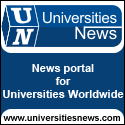Researchers in the Spatial Applications and Research Center (SpARC) at New Mexico State University recently mapped the outdoor recycling bins on campus and determined they are not evenly distributed across campus and need to be closer to buildings. Those who conducted the study predict that relocating the bins may lead to increased recycling.
“The study looked at the population density on campus, where the people are, compared to where the bins are,” said Carol Campbell, associate professor of geography.
SpARC is a research laboratory in the College of Arts and Sciences. Established in 1982, the lab works primarily with federal state and local government agencies, providing services such as planning, image processing, modeling and geographic information systems (GIS).
Mapping of the bins was part of a geospatial project assigned to eight students enrolled in a special topics geography class last semester. A culmination of several assignments, it was designed to give students hands-on experience with GIS while increasing participation in recycling.
Robert Sabie, teaching assistant in the geography department, took the lead on the project.
“Walking around campus a couple of times we were trying to dispose of a plastic bottle and had to walk several hundred yards to find a recycling bin, but at the same time we passed 20 or 30 trashcans,” Sabie said.
The data showed 19 outdoor recycling bins compared to 191 trashcans on the NMSU campus. Of those recycling bins, only 22 percent were located within 25 feet of building, whereas 70 percent of the trashcans were within 25 feet.
Sabie said studies have shown access to recycling bins is one of reasons people recycle. He also noted that students who are not overly concerned with recycling or sustainability were more likely to dispose of recyclables in a trashcan instead of scouting out a blue bin.
“We found the bins to be clumped in distribution, and our primary result here is that relocating some of the bins may make the recycling more efficient, and so that’s our suggestion to the facilities and services group,” Campbell said.
Working with the group from NMSU’s Facilities and Services were Art Lucero, recycling team manager, and Omar Moreno, a recycling technician who regularly talks to Campbell’s students about the importance of recycling.
Students working alongside Sabie were graduate student Kristina Gordon and undergraduates Tom Murphy, Andrew Martinez, Beth Gonzalez, Suzanne Montes, Devin Cahill and Kim Hand.
While the project was designed to inform students about the importance of recycling, Campbell also wanted to showcase the software.
“I wanted to demonstrate the way GIS could provide a spatial image of resources that people could look at, and then see gaps or clusters, and start making some analysis about where the recycling resources were located, and how they were distributed across campus,” Campbell said.
Done over the course of several semesters, students also developed a GIS database of possible recycling resources and mapped the campus collection centers.
“This has evolved from my participation in the campus maps program and my interest in integrating that available technology on to our campus, and making it a resource that everyone can use and access,” Campbell said.
The project culminated with a presentation to NMSU’s Sustainability Council, where Sabie talked about the group’s findings and suggested plans to relocate the bins.
According to Campbell, the council plans to include the mapping information in its annual resources allocation report. Meanwhile, she envisions another mapping project.
“We all have a cell phone, and most of them have GIS/GPS capabilities,” Campbell said. “So my goal is, like other campuses, to allow you to look at your map and find out where a food resource might be, and then where you’re finished with that resource, then finding out where the closest recycling bin would be on track to your next class.”






